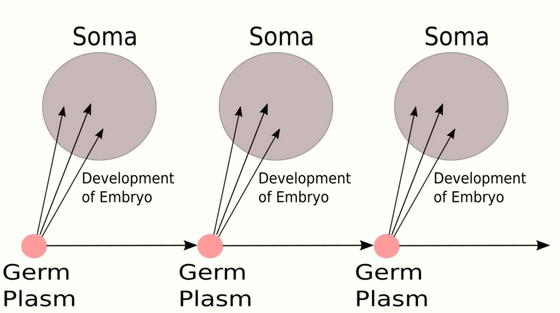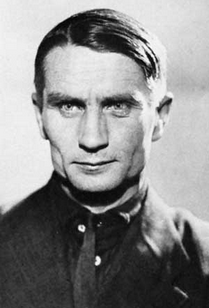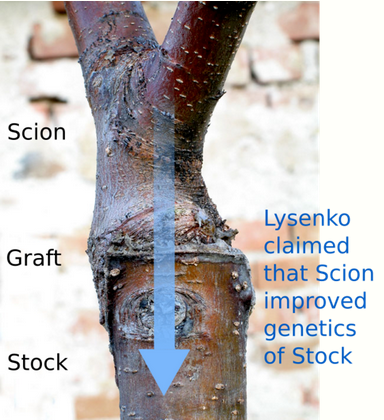
| Version | Summary | Created by | Modification | Content Size | Created at | Operation |
|---|---|---|---|---|---|---|
| 1 | Beatrix Zheng | -- | 2187 | 2022-11-02 01:42:45 |
Video Upload Options
Lysenkoism (Russian: Лысенковщина, romanized: Lysenkovshchina, [ɫɨˈsɛnkəfɕːʲɪnə], Ukrainian: лисенківщина, Template:IPA-uk) was a political campaign led by Trofim Lysenko against genetics and science-based agriculture in the mid-20th century, rejecting natural selection in favour of a form of Lamarckism, as well as expanding upon the techniques of vernalization and grafting. In time, the term has come to be identified as any deliberate distortion of scientific facts or theories for purposes that are deemed politically, religiously or socially desirable. More than 3,000 mainstream biologists were dismissed or imprisoned, and numerous scientists were executed in the campaign to suppress scientific opponents. The president of the Agriculture Academy, Nikolai Vavilov, who had been Lysenko's mentor, but later denounced him, was sent to prison and died there, while Soviet genetics research was effectively destroyed. Research and teaching in the fields of neurophysiology, cell biology, and many other biological disciplines were harmed or banned. Other countries of the Eastern Bloc including the People's Republic of Poland, the Republic of Czechoslovakia, and the German Democratic Republic accepted Lysenkoism as the official "new biology", to varying degrees, as did the People's Republic of China for some years. The government of the USSR supported the campaign, and Joseph Stalin personally edited a speech by Lysenko in a way that reflected his support for what would come to be known as Lysenkoism, despite his skepticism toward Lysenko's assertion that all science is class-oriented in nature. Lysenko served as the director of the Soviet Union's Lenin All-Union Academy of Agricultural Sciences.
1. Context

Mendelian genetics, the science of heredity, developed into an experimentally-based field of biology at the start of the 20th century through the work of August Weismann, Thomas Hunt Morgan, and others, building on the rediscovered work of Gregor Mendel. They showed that the characteristics of an organism were carried by inherited genes, which were located on chromosomes in each cell's nucleus. These could be affected by random changes, mutations, and could be shuffled and recombined during sexual reproduction, but were otherwise passed on unchanged from parent to offspring. Beneficial changes could spread through a population by natural selection or, in agriculture, by plant breeding.[2] In contrast, Lamarckism proposes that an organism can somehow pass on characteristics that it has acquired during its lifetime to its offspring, implying that change in the body can affect the genetic material in the germ line.[2][3]
Marxism–Leninism postulated "universal and immutable laws of history" (historical materialism and dialectical materialism), which assumed unavoidable large-scale change at the collective level of societies.[4] Collectivism was a key feature of Marxism; Darwin's concept of a random mutation in an individual being able to propagate and transform subsequent generations was at odds with the ideology, and was perceived as having a strong liberal inclination.[5] Marxist–Leninist theorists presented Lysenkoism as a new branch of biology, arguing that "dialectic method shows that development is carried out in a dual form: evolutionary and revolutionary." Darwin was attributed with discovering "only the evolutionary" path, while Michurin and Lysenko were presented as making a "great step forward" toward the discovery of a "revolutionary" path of biologic development.[6]
Soviet agriculture around 1930 was in a crisis due to the forced collectivisation of farms, and the extermination of the kulak peasant farmers. The resulting famine in 1932–33 provoked the government to search for a solution to the critical lack of food.[7] Lysenko's attack on the "bourgeois pseudoscience" of modern genetics and the proposal that plants can rapidly adjust to a changed environment suited the ideological battle in both agriculture and Soviet society.[8][9] State media published enthusiastic articles such as "Siberia is transformed into land of orchards and gardens," "Soviet people change nature" while anyone opposing Lysenko was presented as a defender of "mysticism, obscurantism and backwardness/"[6]
2. In the Soviet Union
2.1. Lysenko's Claims

In 1928, rejecting natural selection and Mendelian genetics, Trofim Lysenko claimed to have developed agricultural techniques which could radically increase crop yields. These included vernalization, species transformation, inheritance of acquired characteristics, and vegetative hybridization.[2] He claimed in particular that vernalization, exposing wheat seeds to humidity and low temperature, could greatly increase crop yield. He claimed further that he could transform one species, Triticum durum (pasta wheat, a spring wheat), into another, Triticum vulgare (bread wheat, an autumn wheat), by 2–4 years of autumn planting. Since T. durum is a tetraploid with 28 chromosomes (4 sets of 7), and T. vulgare is hexaploid with 42 chromosomes (6 sets), Western geneticists at that time already knew this was impossible.[2]

Lysenko further claimed that Lamarckian inheritance of acquired characteristics occurred in plants, as in the "eyes" of potato tubers, though the genetic differences in these plant parts were already known to be somatic mutations.[2][10] He also claimed that when a tree is grafted, the scion permanently changes the heritable characteristics of the stock. This would constitute vegetative hybridization, which Yongsheng Liu and colleagues note could possibly occur by horizontal gene transfer.[9]
2.2. Rise
Isaak Izrailevich Prezent brought Lysenko to public attention, using Soviet propaganda to portray him as a genius who had developed a new, revolutionary agricultural technique. Lysenko's resulting popularity gave him a platform to denounce theoretical genetics and to promote his own agricultural practices. He was, in turn, supported by the Soviet propaganda machine, which overstated his successes, cited faked experimental results, and omitted mention of his failures.[11]
Lysenko's political success was mostly due to his appeal to the Communist Party and Soviet ideology. Following the disastrous collectivization efforts of the late 1920s, Lysenko's "new" methods were seen by Soviet officials as paving the way to an "agricultural revolution." Lysenko himself was from a peasant family, and was an enthusiastic advocate of Leninism.[9][12] The Party-controlled newspapers applauded Lysenko's "practical" efforts and questioned the motives of his critics.[12] Lysenko's "revolution in agriculture" had a powerful propaganda advantage over the academics, who urged the patience and observation required for science.[13] Lysenko was admitted into the hierarchy of the Communist Party, and was put in charge of agricultural affairs. He used his position to denounce biologists as "fly-lovers and people haters,"[14] and to decry the "wreckers" in biology, who he claimed were trying to disable the Soviet economy and cause it to fail. Furthermore, he denied the distinction between theoretical and applied biology and concepts such as control groups and statistics in general:[15]
We biologists do not take the slightest interest in mathematical calculations, which confirm the useless statistical formulae of the Mendelists … We do not want to submit to blind chance … We maintain that biological regularities do not resemble mathematical laws
Lysenko presented himself as a follower of Ivan Vladimirovich Michurin, a well-known and well-liked Soviet horticulturist, but unlike Michurin, he advocated a form of Lamarckism, insisting on using only hybridization and grafting, as non-genetic techniques.[2]
Support from Joseph Stalin increased Lysenko's momentum and popularity. In 1935, Lysenko compared his opponents in biology to the peasants who still resisted the Soviet government's collectivization strategy, saying that by opposing his theories the traditional geneticists were setting themselves against Marxism. Stalin was in the audience when this speech was made, and he was the first one to stand and applaud, calling out "Bravo, Comrade Lysenko. Bravo."[16] This emboldened Lysenko, and gave him and Prezent free rein to slander any geneticists who still spoke out against him. Many of Lysenkoism's opponents, such as his former mentor Nikolai Ivanovich Vavilov, were imprisoned or executed because of their denunciations.[12][17]
On August 7, 1948, at the end of a week-long session organised by Lysenko and approved by Stalin,[13] the V.I. Lenin Academy of Agricultural Sciences announced that from that point on Lysenkoism would be taught as "the only correct theory." Soviet scientists were forced to denounce any work that contradicted Lysenko.[18] Criticism of Lysenko was denounced as "bourgeois" or "fascist," and analogous "non-bourgeois" theories also flourished in other fields such as linguistics and art in the Soviet academy at this time. Perhaps the only opponents of Lysenkoism during Stalin's lifetime to escape liquidation were from the small community of Soviet nuclear physicists: as Tony Judt has observed, "It is significant that Stalin left his nuclear physicists alone and never presumed to second guess their calculations. Stalin may well have been mad but he was not stupid."[19]
2.3. Effects
From 1934 to 1940, under Lysenko's admonitions and with Stalin's approval, many geneticists were executed (including Isaak Agol, Solomon Levit, Grigorii Levitskii, Georgii Karpechenko and Georgii Nadson) or sent to labor camps. The famous Soviet geneticist and president of the Agriculture Academy, Nikolai Vavilov, was arrested in 1940 and died in prison in 1943.[20]
In 1936, the American geneticist Hermann Joseph Muller, who had moved to the Leningrad Institute of Genetics with his Drosophila fruit flies, was criticized as a bourgeois, capitalist, imperialist, and promoter of fascism, so he left the USSR, returning to America via Republican Spain.[21] In 1948, genetics was officially declared "a bourgeois pseudoscience".[22] Over 3,000 biologists were imprisoned, fired, or executed for attempting to oppose Lysenkoism and genetics research was effectively destroyed until the death of Stalin in 1953. Due to Lysenkoism, crop yields in the USSR actually declined.[23][24][25][26]
2.4. Fall
At the end of 1952, the situation started to change, and newspapers published articles criticizing Lysenkoism. However, the process of return to regular genetics slowed down in Nikita Khrushchev's time, when Lysenko showed him the supposed successes of an experimental agricultural complex. It was once again forbidden to criticize Lysenkoism, though it was now possible to express different views, and the geneticists imprisoned under Stalin were released or rehabilitated posthumously. The ban was finally waived in the mid-1960s.[27][28] In the West, meanwhile, Lysenkoism increasingly became seen as pseudoscience.[29]
2.5. Reappearance
In the 21st century, Lysenkoism is again being discussed in Russia, including in "respectable"[28] newspapers like Kultura and by biologists. The geneticist Lev Zhivotovsky has made the unsupported[28] claim that Lysenko helped to found modern developmental biology.[28] Discoveries in the field of epigenetics were sometimes raised as alleged late confirmation of Lysenko theory, but in spite of the apparent high-level similarity (heritable traits passed without DNA alterations), Lysenko believed that environment-induced changes are the primary mechanism of heritability. Heritable epigenetic effects were found but are minor as compared to genetic and often unstable.[30]
3. In Other Countries
Other countries of the Eastern Bloc accepted Lysenkoism as the official "new biology," to varying degrees.
In communist Poland, Lysenkoism was aggressively pushed by state propaganda. State newspapers attacked "damage caused by bourgeois Mendelism-Morganism," "imperialist genetics," compared it to Mein Kampf — for example, Trybuna Ludu published article titled "French scientists recognize superiority of Soviet science" by Pierre Daix, a French communist and chief editor of Les Lettres Françaises, who basically reworded Soviet propaganda claims, which was intended to create an impression that Lysenkoism was already accepted by the whole progressive world.[6] The scientific community, however, opposed the introduction of Lysenkoism. Some academics accepted it for political reasons, with Wacław Gajewski being a notable and vocal opponent to forced introduction of Lysenkoism into universities.[31] As a result he was denied contact with students, but was able to continue his scientific work at the Warsaw botanical garden. Lysenkoism was rapidly rejected from 1956 and the first department of genetics, at the University of Warsaw, was founded in 1958 with Gajewski as its head.[31]
Communist Czechoslovakia adopted Lysenkoism in 1949. Jaroslav Kříženecký (1896–1964) was one of the prominent Czechoslovak geneticists opposing Lysenkoism, and when he criticized Lysenkoism in his lectures, he was dismissed from the Agricultural University in 1949 for "serving the established capitalistic system, considering himself superior to the working class, and being hostile to the democratic order of the people," and imprisoned in 1958.[32]
In the German Democratic Republic, although Lysenkoism was taught at some of the universities, it had very little impact on science due to the actions of a few scientists (for example, the geneticist and fierce critic of Lysenkoism, Hans Stubbe) and information exchange with West Berlin research institutions. Nonetheless, Lysenkoist theories were found in schoolbooks as late as the dismissal of Nikita Khrushchev in 1964.[33]
Lysenkoism dominated Chinese science from 1949 until 1956, particularly during the Great Leap Forward, when, during a genetics symposium opponents of Lysenkoism were permitted to freely criticize it and argue for Mendelian genetics.[34] In the proceedings from the symposium, Tan Jiazhen is quoted as saying "Since [the] USSR started to criticize Lysenko, we have dared to criticize him too".[34] For a while, both schools were permitted to coexist, although the influence of the Lysenkoists remained large for several years, contributing to the Great Famine through loss of yields.[34]
Almost alone among Western scientists, John Desmond Bernal, Professor of Physics at Birkbeck College, London, a Fellow of the Royal Society, and a communist,[35] made an aggressive public defence of Lysenko.[36]
References
- Huxley, Julian (1942). Evolution, the Modern Synthesis. p. 17.
- Leone, Charles A. (1952). "Genetics: Lysenko versus Mendel". Transactions of the Kansas Academy of Science 55 (4): 369–380. doi:10.2307/3625986. ISSN 0022-8443. https://dx.doi.org/10.2307%2F3625986
- Ghiselin, Michael T. (1994). "The Imaginary Lamarck: A Look at Bogus "History" in Schoolbooks". The Textbook Letter (September–October 1994). http://www.textbookleague.org/54marck.htm. Retrieved 12 December 2019.
- Kolakowski, Leszek (2005). Main Currents of Marxism. W. W. Norton & Company. ISBN 978-0393329438.
- Kautsky, John H., ed (1989). "Karl Kautsky: Nature and Society (1929)". https://www.marxists.org/archive/kautsky/1929/12/naturesoc.htm. "For Marx, the mass is the carrier of development, for Darwin it is the individual, though not as exclusively as for many of his disciples. He by no means rejected the doctrine of Lamarck who regarded the progressive adaptation of organisms to the environment as the most important factor in their development."
- "Lysenkoist propaganda in Trybuna Ludu". https://cyberleninka.ru/article/n/lysenkoist-propaganda-in-trybuna-ludu/viewer.
- Ellman, Michael (June 2007). "Stalin and the Soviet Famine of 1932–33 Revisited". Europe-Asia Studies 59 (4): 663–693. doi:10.1080/09668130701291899. http://www.paulbogdanor.com/left/soviet/famine/ellman1933.pdf.
- Geller, Mikhail (1988). Cogs in the wheel : the formation of Soviet man. Knopf. ISBN 978-0394569260.
- Liu, Yongsheng; Li, Baoyin; Wang, Qinglian (2009). "Science and politics". EMBO Reports 10 (9): 938–939. doi:10.1038/embor.2009.198. ISSN 1469-221X. PMID 19721459. http://www.pubmedcentral.nih.gov/articlerender.fcgi?tool=pmcentrez&artid=2750069
- Asseyeva, T. (1927). "Bud mutations in the potato and their chimerical nature". Journal of Genetics 19: 1–28. doi:10.1007/BF02983115. https://link.springer.com/content/pdf/10.1007%2FBF02983115.pdf.
- Rispoli, Giulia (2014). "The Role of Isaak Prezent in the Rise and Fall of Lysenkoism". Ludus Vitalis 22 (42). http://www.ludus-vitalis.org/ojs/index.php/ludus/article/view/4.
- Graham, Loren R. (1993). Science in Russia and the Soviet Union: A Short History. Cambridge University Press. pp. 124–128. ISBN 978-0-521-28789-0. https://books.google.com/books?id=m_wPpj64GqMC&pg=PA127.
- Borinskaya, Svetlana A.; Ermolaev, Andrei I.; Kolchinsky, Eduard I. (2019). "Lysenkoism Against Genetics: The Meeting of the Lenin All-Union Academy of Agricultural Sciences of August 1948, Its Background, Causes, and Aftermath". Genetics 212 (1): 1–12. doi:10.1534/genetics.118.301413. ISSN 0016-6731. PMID 31053614. http://www.pubmedcentral.nih.gov/articlerender.fcgi?tool=pmcentrez&artid=6499510
- Epistemology and the Social, Evandro Agazzi, Javier Echeverría, Amparo Gómez Rodríguez, Rodopi, 2008, "Philosophy", p. 149 https://books.google.com/books?id=xBvbQgWtgjsC&pg=PA149
- Faulk, Chris (2013-06-21). "Lamarck, Lysenko, and Modern Day Epigenetics" (in en-US). http://www.mindthesciencegap.org/2013/06/21/lamarck-lysenko-and-modern-day-epigenetics/.
- Cohen, Richard (3 May 2001). "Political Science". The Washington Post. https://www.washingtonpost.com/archive/opinions/2001/05/03/political-science/ec1489dc-fc49-475c-a2a7-db396fee9160/.
- Harper, Peter S. (2017). "Lysenko and Russian genetics: Reply to Wang & Liu". European Journal of Human Genetics 25 (10): 1098. doi:10.1038/ejhg.2017.118. ISSN 1018-4813. PMID 28905879. http://www.pubmedcentral.nih.gov/articlerender.fcgi?tool=pmcentrez&artid=5602019
- Wrinch, Pamela N. (July 1951). "Science and Politics in the U.S.S.R.: The Genetics Debate". World Politics 3 (4): 486–519. doi:10.2307/2008893. https://dx.doi.org/10.2307%2F2008893
- Judt, Tony (2006). Postwar: A History of Europe Since 1945. New York: Penguin Books. p. 174n.
- Cohen, Barry Mandel (1991). "Nikolai Ivanovich Vavilov: the explorer and plant collector". Economic Botany 45 (1 (Jan-Mar 1991)): 38–46. doi:10.1007/BF02860048. https://dx.doi.org/10.1007%2FBF02860048
- Carlson, Elof Axel (1981). Genes, radiation, and society: the life and work of H. J. Muller. Ithaca, NY: Cornell University Press. pp. 184–203. ISBN 978-0801413049.
- Gardner, Martin (1957). Fads and Fallacies in the Name of Science. New York: Dover Books. pp. 140–151. ISBN 978-0486131627. https://books.google.com/books?id=TwP3SGAUsnkC&q=gardner%20fads%20and%20fallacies&pg=PP1.
- Wade, Nicholas (June 17, 2016). "The Scourge of Soviet Science". https://www.wsj.com/articles/the-scourge-of-soviet-science-1466192179.
- Swedin, Eric G. (2005). Science in the Contemporary World : An Encyclopedia. Santa Barbara, California: ABC-CLIO. pp. 168, 280. ISBN 978-1851095247. https://archive.org/details/sciencecontempor00swed.
- Soyfer, Valery N. (1 September 2001). "The Consequences of Political Dictatorship for Russian Science". Nature Reviews Genetics 2 (9): 723–729. doi:10.1038/35088598. PMID 11533721. https://dx.doi.org/10.1038%2F35088598
- deJong-Lambert, William (2017). The Lysenko Controversy as a Global Phenomenon, Volume 1: Genetics and Agriculture in the Soviet Union and Beyond. Palgrave Macmillan. p. 104. ISBN 978-3319391755.
- Alexandrov, Vladimir Yakovlevich (1993). Трудные годы советской биологии: Записки современника. Наука ["Science"]. http://vivovoco.astronet.ru/VV/BOOKS/ALEXANDROV/CONTENT.HTM.
- Kolchinsky, Edouard I.; Kutschera, Ulrich; Hossfeld, Uwe; Levit, Georgy S. (2017). "Russia's new Lysenkoism". Current Biology 27 (19): R1042–R1047. doi:10.1016/j.cub.2017.07.045. ISSN 0960-9822. PMID 29017033. which cites Graham, Loren (2016). Lysenko's Ghost: Epigenetics and Russia. Harvard University Press. ISBN 978-0-674-08905-1. https://books.google.com/books?id=IUu6CwAAQBAJ.
- Gordin, Michael D. (2012). "How Lysenkoism Became Pseudoscience: Dobzhansky to Velikovsky". Journal of the History of Biology 45 (3): 443–468. doi:10.1007/s10739-011-9287-3. ISSN 0022-5010. PMID 21698424. https://dx.doi.org/10.1007%2Fs10739-011-9287-3
- Graham, Loren (2016). Lysenko's Ghost: Epigenetics and Russia. Harvard University Press. ISBN 978-0-674-08905-1.
- Gajewski W. (1990). "Lysenkoism in Poland". Quarterly Review of Biology 65 (4): 423–34. doi:10.1086/416949. PMID 2082404. https://dx.doi.org/10.1086%2F416949
- Orel, Vitezslav (1992). "Jaroslav Kříženecký (1896–1964), Tragic Victim of Lysenkoism in Czechoslovakia". Quarterly Review of Biology 67 (4): 487–494. doi:10.1086/417797. https://dx.doi.org/10.1086%2F417797
- Hagemann, Rudolf (2002). "How did East German genetics avoid Lysenkoism?". Trends in Genetics 18 (6): 320–324. doi:10.1016/S0168-9525(02)02677-X. PMID 12044362. https://dx.doi.org/10.1016%2FS0168-9525%2802%2902677-X
- Li, C. C. (1987). "Lysenkoism in China". Journal of Heredity 78 (5): 339. doi:10.1093/oxfordjournals.jhered.a110407. https://dx.doi.org/10.1093%2Foxfordjournals.jhered.a110407
- Witkowski, J. A. (2007). "J. D. Bernal: The Sage of Science by Andrew Brown (2006), Oxford University Press". The FASEB Journal 21 (2): 302–304. doi:10.1096/fj.07-0202ufm. https://dx.doi.org/10.1096%2Ffj.07-0202ufm
- Goldsmith, Maurice (1980). Sage: A Life of J. D. Bernal. London: Hutchinson. pp. 105–108. ISBN 0-09-139550-X.




